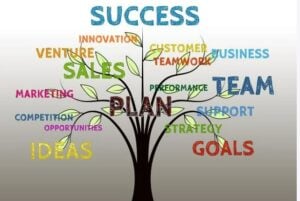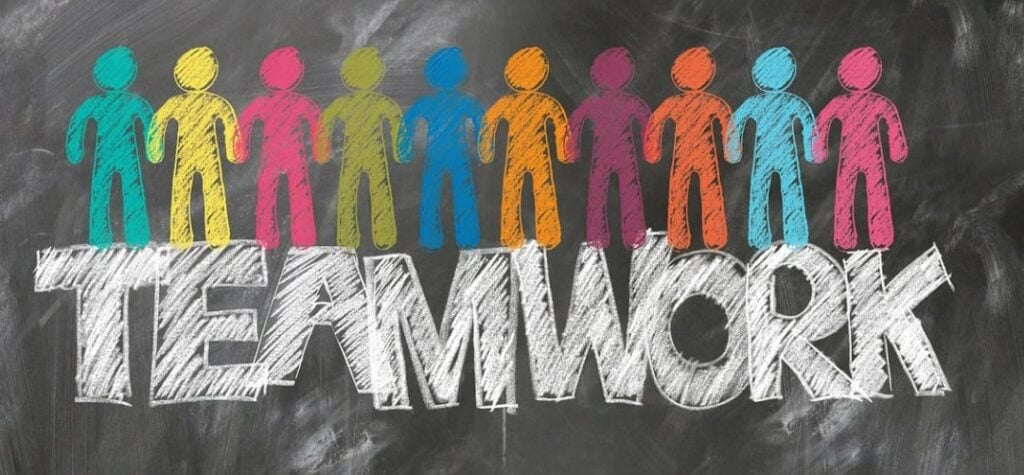People have different backgrounds, cultures, ethnicities and expectations. When individuals work together, there is often brilliance but at the same time, there is often friction. It is important to take the necessary steps to ensure team members can work together successfully and achieve objectives with minimal stress. This article will discuss some tried and tested methods used to reduce stress and create better teams.
Communication is a crucial part of teamwork success so let`s start there.
Communication is the key to success.
“Good communication is just as stimulating as black coffee, and just as hard to sleep after.” – Anne Morrow Lindbergh
Excellent communication is at the centre of great teamwork in the workplace. Awesome teams communicate often and clearly. Team members are content to brainstorm together, ask for feedback, share ideas, and receive constructive criticism.
Team members don´t always agree but variety is the spice of life and moving forwards and resolving conflict and differences of opinion is a skill that leads to success.
But how can we improve communication between team members? Here are five tips.
Tips to Enhance Communication and Enhance Team-Building Skills.
1. Be Crystal Clear
Set clear boundaries and clear guidelines. It´s a good idea to write these and provide easy access to all team members. It is important for everyone to be on the same page, and this starts with clarity and getting feedback on the set guidelines to ensure that team members understand their roles.
2. Listen attentively

“The most important thing in communication is to hear what isn’t being said.” – Peter Drucker
Communication is a two-way street. Listen to fellow team members, take notes and act accordingly when responding to questions and queries. Consider all angles before offering input and solutions. Provide the opportunity for team members to have private communication to express their feelings if necessary. Everyone appreciates a good listener and good listeners reap the rewards of their attentive listening. Good listeners are not passive. They ask questions, take notes, and ensure they understand clearly what is being said and why the speaker is saying it.
3. Choose the most suitable platform to communicate.
“Wi-Fi went down for five minutes, so I had to talk to my family. They seem like nice people.”
There are so many ways to reach each other these days. Try to use the most suitable tool to communicate your specific needs, whether that is faced to face, social media, email, a chat, or a phone call. Ensure that team members have access to the chosen platforms and are happy and comfortable using them.
WhatsApp and Telegram groups can be useful but in large groups where there is a lot of communication ensure members send private messages when necessary. Receiving incessant notifications can be disturbing and contribute to decreased work output.
Technology is great when it works well but it can be a pain when things backfire. Always have a plan B if Zoom crashes or there is a weak signal or team members become uncontactable for whatever reason on one platform. Share email addresses, phone numbers and contact details of team members.
4. Stay connected

Encourage information sharing and informal meetings between team members. Constant collaboration is useful for relationship building and ultimate success. Team members should have clear guidelines about how and when they touch base. Lack of communication can be detrimental to the success of projects.
5. Choose professional tools to collaborate

Ensure team members have access to necessary documents and are able and comfortable using collaborative tools such as Microsoft Teams or Google Drive. If members are not confident using them, organize training, get feedback, and react to the feedback. Surveys are easy to make and can provide useful anonymous feedback which can help improve productivity. Technology is constantly changing, and team members need to stay informed and keep up with developments.
Teamwork Skills – Activities to Improve Teamwork Skills
Here are ten simple activities which can work wonders in the workplace:
1 Take sufficient breaks.
“Sometimes when we take a break, we may find that solutions then present themselves.”- Catherine Pulsifer
There is an adage which states that “All work and no play makes Jack a dull boy.” Taking regular breaks helps to invigorate team members and make them feel valued and not overworked. Providing healthy snacks and drinks can also increase productivity. Working on an empty stomach is difficult and unproductive.
Teamwork in the workplace should be broken up into manageable chunks. People have different eating habits, and they need energy to work. Breaks are important and should be scheduled and management should try to ensure that schedules are adhered to.
Consider too the best time of the week to conduct activities. Five 5pm on a Friday or first thing Monday morning may not be the best time to get the most out of team members. Plan and get feedback and act accordingly.

2. Embrace diversity
“Diversity may be the hardest thing for a society to live with and the most dangerous thing for a society to be without.”
– William Sloane Coffin Jr
We live in an ever diverse, multicultural world, full of people from a plethora of different walks of lives who all bring different talents when they engage in teamwork in the workplace. People have different religions, different ideologies, different identities, and diverse ways to express themselves.
People from diverse cultures have diverse mannerisms too. In some countries it is considered offensive to show anger or frustration whereas in some segments of society it can be looked upon favorably in some circumstances.
Embracing diversity is a necessary component of teamwork in the workplace. There are many activities which can help peers to learn about the etiquette and mannerisms of their colleagues and learn to value this diversity as a strength and not an obstacle in the attainment of collective goals. These days people have preferred pronouns and different gender identities, and all these things need to be considered to create a harmonious work environment.

3. Establish clear team rules and expectations.
“Learn the rules like a pro, so you can break them like an artist.”
― Pablo Picasso
Team members who know the rules and expectations of their team can be more productive. Be clear about what you expect. Some work better when they have clear deadlines and having a collective objective is extremely useful and great for relationship building and getting the task at hand completed.
Some examples of rules for teamwork in the workplace might include:
- Be punctual for meetings and message members if you are being delayed.
- Refrain from using phones during meetings.
- Avoid messaging colleagues outside of office hours.
- Only message relevant information to relevant people at relevant times.
- Take and publish minutes.
- Provide an agenda for meetings.
- Allocate enough time for all members to have their say.
4. Create a harmonious workspace
“Always aim at complete harmony of thought, word, and deed. Always aim at purifying your thoughts and everything will be well.”
-Mahatma Gandhi.
Google and its Russian competitor Yandex are leaders in this ever-developing, new concept of making the workspace a productive place where fun, creativity and relaxation go hand in hand with the daily grind. Smart employers have recognized that workers produce more and are more creative in comfortable, stimulating environments that enhance teamwork in the workplace as well as independent and innovative thinking.
5. Build Relationships.
“Develop an intentional relationship building with people that matters in your life. Never be casual about your relationships except the relationships that adds no value to your life.”
― Benjamin Suulola
Investing time to build relationships between team members can be very productive on a micro and macro level. Humans are social animals and respond well in social interactions. So, take time to build relationships and everybody will reap the rewards. Simple things like pairing team members who are friends and who can work well together can also be very successful.
Activities like coffee mornings, potlucks and some fun tasks at meetings can help break the ice and develop bonds between stakeholders. Team members who are comfortable with their peers and environment are more likely to achieve more. Happiness and positivity enhance creativity and collaboration. Go out for dinner or drinks or go bowling or dancing. If face-to-face activities are not possible, play some games on Zoom or open the break-out rooms and get individuals to collaborate and get to know each other.
6. Clarify purpose.
“Clarify your purpose. What is the why behind everything you do? When we know this in life or design it is very empowering and the path is clear.”– Jack Canfield.
Clarification of objectives and purpose is a key element in teamwork in the workplace. People need to have a common goal and a clear reason to work together to achieve that goal.
Explain to team members why they are doing something. People have different ways of doing things and different ways of looking at the world but when they know why they are doing something it helps.
If you ask a team to brainstorm ideas for a company presentation at an international exposition, they know what to do. However, if you tell them to brainstorm because they will be involved in an exhibition in 2 months, they may produce better ideas.
7. Exercise together.
“When it comes to health and well-being, regular exercise is about as close to a magic potion as you can get.” Tich Nhat Hanh
Exercising, sport, and games build bonds between players. The frequency of team building exercises is crucially important. Team building exercises are like working out at the gym, if you do it often, the results last longer. You cannot run a marathon if you train once a month. Teamwork is the same. If you want to succeed in your teamwork goals, work the exercises into your regular contact with your team members.

8. Reward and recognize.
“Keep your eyes open and try to catch people in your company doing something right, then praise them for it.”
~ Tom Hopkins
Satisfied employees are recognized employees and they are more productive. If you want a happier, stronger team, recognize individuals. This doesn´t have to involve a financial bonus, a simple in-person recognition and thanks or even an email can boost morale and foster satisfaction.
9. Celebrate
Like gratitude and recognition, celebrations don´t have to be over the top. A simple cake or free snacks and coffee in the office can work wonders for morale and team building. Celebrations should, however, be frequent as humans naturally celebrate success and it is a healthy, beneficial activity for all stakeholders. Amalgamating small celebrations into the culture of a team reaps impactful rewards. It reminds stakeholders that objectives are worth striving for, that they can be achievable and that they are a great tool for boosting motivation. Successful teams celebrate together and acknowledge their hard work. This creates mutually beneficial bonds and develops great rapport and cooperation.
10. Focus on strengths
Adopting a culture of positivity and focusing on strengths is important for successful teamwork. There are many activities that can be completed to teach members that it is more beneficial to see the proverbial “glass” as “half full” instead of “half empty.” Challenging situations can bring out the best in people and as the old saying goes “as one door closes another open.”
Conclusion
Creating a harmonious team with members who work together and overcome challenges is very rewarding. Like all relationships, teamwork requires work and constant upgrades and tweaking. Teams that play together stay together.
Patrick is from Ireland and has been teaching for the last twenty years. He has worked in Malaysia, Myanmar, India, Spain, Japan, Taiwan, Oman, and Saudi Arabia. He has a degree in English Literature and Applied Psychology. Patrick loves travelling and learning about new cultures. He is passionate about motivating students to maximize their creative potential.








































